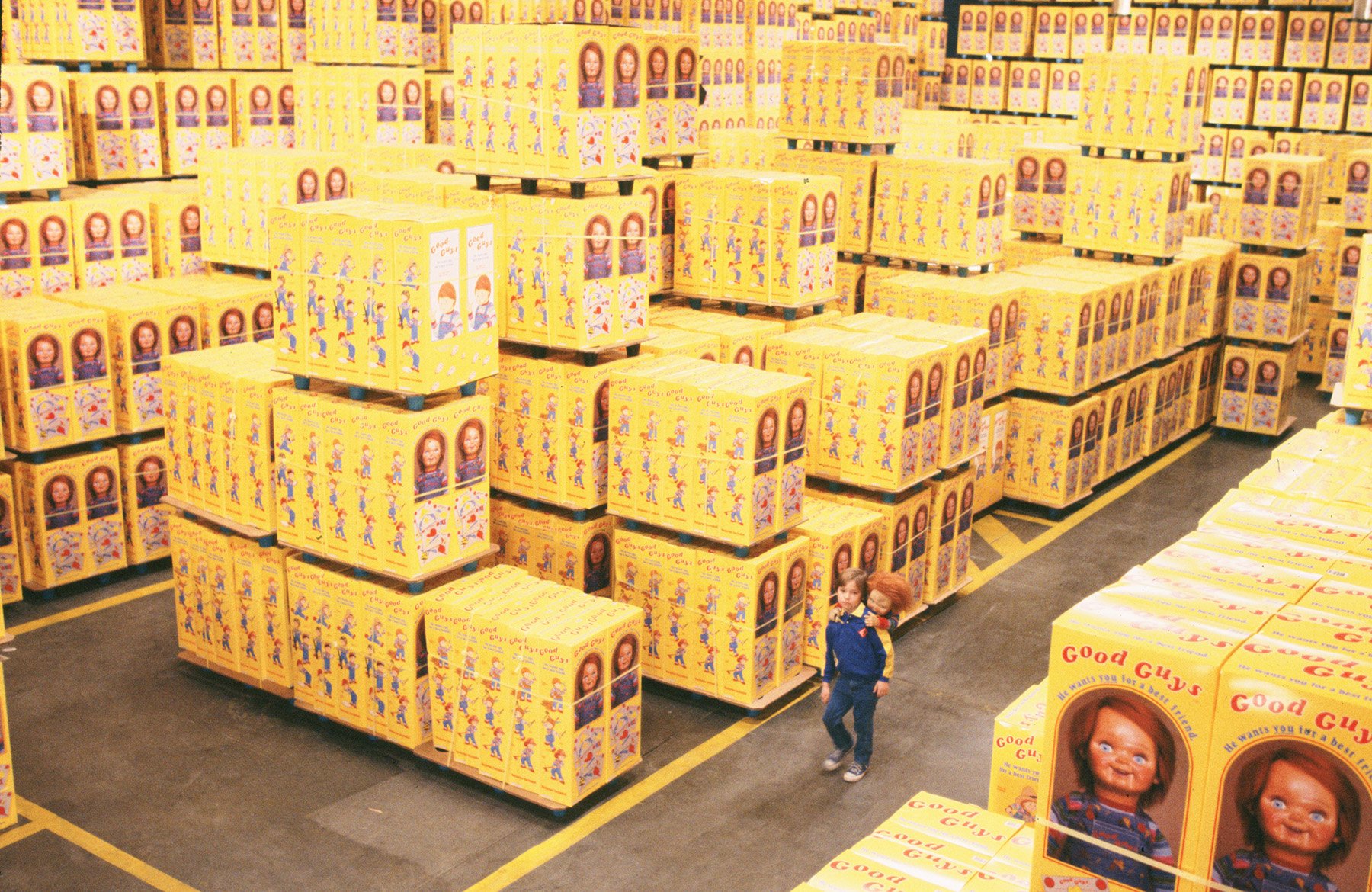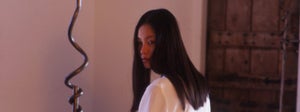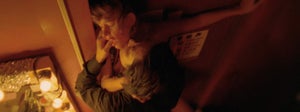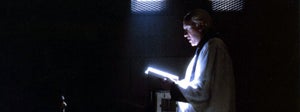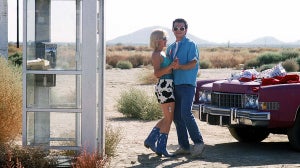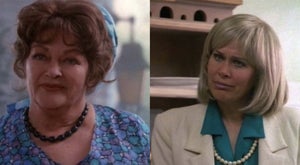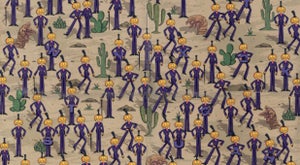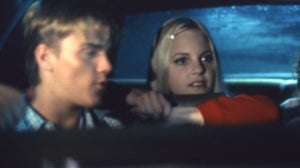
Horror trends may come and go, but it seems as though creepy dolls will always be with us. Whether it's due to the juxtaposition of seeming innocence with unbridled malevolence, or simply the sheer uncanny valley-ness of it all, it appears audiences have never stopped being scared by the prospect of an apparently harmless plaything turning evil. From the 1945 Ealing classic Dead of Night up to latter-day Blumhouse hits such as Annabelle (2014) and M3GAN (2022), dolls have proven to be just as much of a mainstay in genre cinema as they have in the toy boxes of generations of small children. So, as Arrow prepare to release a Child's Play boxset collecting the murderous cinematic exploits of everyone's favourite Good-Guy-turned-bad Chucky, we thought we'd compile a list of other, equally devilish, dolls...
Dead of Night (1945)
Still considered one of the best anthology horror films ever made, it's also widely accepted that the stand-out episode in Dead of Night is its concluding segment, “The Ventriloquist's Dummy” (directed by Alberto Cavalcanti). Almost eighty years after the film's original release, it may be true that the trope of the malign dummy has long since passed into horror cliché; but this doesn't serve to remotely lessen just how unnerving this particular story is. The episode's titular dummy Hugo Fitch is one of cinema's creepiest ever dolls, his constant stream of vaudeville patter and snide put-downs barely serving to mask the unbridled malevolence lurking behind his frozen grin. (Acknowledgment must also go to the oft-uncredited character actor John McGuire for voicing Hugo; this is surely one of the great voice-only performances in genre cinema, ranking up with Mercedes McCambridge in The Exorcist.) But what Dead of Night also makes clear is that this kind of plot requires a powerhouse actor to really sell it; if your lead performer can't convince an audience of the notion that a lifeless mannequin might be possessed by some kind of nameless evil (be it real or imagined), then the whole conceit will quickly fall apart. Luckily, Cavalcanti's film has Michael Redgrave, whose unhinged performance as Hugo's doomed handler is a marvel, by turns crazed and sweatily terrified. Simply put, this episode of Dead of Night is one of those stand-out works that managed to define an entire sub-genre single-handedly; just look at the fact that its closing twist was outright copied by two of the other films on this list.
https://www.youtube.com/watch?v=8UCJz617E8s
Trilogy of Terror (1975)
The 1970's were the great era of American made-for-TV terror. The genre movies made for American network television during this period provided audiences with an apparently inexhaustible stream of Satanic conspiracies, haunted houses and alien invasions. However, due to the stultifying grip of the various channels' Standards and Practices departments, much of what was produced at the time now appears incredibly tame to modern-day sensibilities. Not so the final segment of Dan Curtis' anthology horror TV movie Trilogy of Terror. Much like Dead of Night before it, the film saves what is easily its best segment for last (the other two episodes are fairly run-of-the-mill). Faithfully adapted from Richard Matheson's short story “Prey”, Stephen King called the vignette “a bloody, gripping, scary fifteen minutes” and proclaimed star Karen Black's performance “a tour-de-force.” The plot is almost childishly simple in its specifics: a lonely young woman buys an African fetish doll as a birthday present for her new boyfriend, only to discover that the statuette is possessed by the spirit of a murderous tribesman. In less skilled hands, the episode might have proven utterly ludicrous, but Curtis and Black succeed in turning the doll's rampage into something genuinely gruelling and nightmarish; no mean feat considering the film's small-screen origins. And similarly to Dead of Night, the episode quickly became a lodestone for other genre creators; certain sequences in Joe Dante's Gremlins (1984) seem undeniably influenced by it, and Child's Play contains a couple of explicit call-outs to Curtis' film.
https://www.youtube.com/watch?v=vt2E3F4xlWo
Suddenly in the Dark (1981)
This South Korean oddity, a genre spin on Kim Ki-young's seminal The Housemaid (1960), mixes psychological horror with prurient eroticism, while also managing to find room for yet another creepy doll. This time the mannequin in question belongs to a naive country girl who is employed to work as a live-in maid for a wealthy middle-class family. The girl inherited the doll from her mother, a shamanic priestess who claimed the figurine was inhabited by a spirit that would always watch over her daughter. While the doll itself is nowhere near as unsettling as those previously seen in Dead of Night or Trilogy of Terror, what really makes the film work is Kim Young-ae's performance as the mother of the family. As the new maid slowly insinuates herself into the day-to-day life of the household, the mother becomes increasingly paranoid that her husband is conducting a clandestine affair with their young employee, while also fighting to quell her own repressed lesbian feelings towards the girl. Once again, we see the vital importance of a strong central characterisation to these sorts of stories: Suddenly in the Dark is unthinkable without Kim's carefully delineated portrait of female neurosis and paranoia. The film's pivotal ambiguity is one that we see reoccur time and time again within the sub-genre: is the doll truly malevolent or is the protagonist simply losing her mind? Much like Dead of Night, Suddenly in the Dark never definitively answers that question, and is all the better for it.
https://www.youtube.com/watch?v=p1hzvPOahTg
Child's Play (1987)
A modest hit upon its initial release, I'm not sure anyone who saw Child's Play at the time ever predicted the sheer longevity the franchise would go on to enjoy. But here we are, some six sequels plus a TV series plus a remake later, with Chucky an undeniably popular fixture in the horror villains pantheon. Of course, a great deal of credit for that must go to the man who voiced Chucky: actor Brad Dourif, who has continued to play the character in every subsequent iteration of the series save the 2019 reboot. As we've already seen, many other evil doll movies tend to be reliant upon their human characters to sell the concept – but the Child's Play franchise is Dourif's show all the way. Much like Robert Englund in the Nightmare on Elm Street series, he took what could have been a gimmicky slasher villain and gave the character a gleefully malign wit. As a result, both franchises quickly became centred around their antagonists; no one is watching the Child's Play or Elm Street movies for the rather bland heroes, all they really want to see is more Chucky or Freddy. However, in a series that has become increasingly comic and metafictional over time, how does the original Child's Play hold up today? Watching it again, I was most struck by the filmmaking craft displayed by director Tom Holland. Back in the 1980s, there was a decided limit to what practical FX could enable Chucky to do, and as a result the director leans heavily upon peekaboo suspense techniques; a throwback to an older way of making movies that helps lend Child's Play an enviably timeless quality. Special effects techniques may come and go, but old-school filmmaking chops are eternal – much like Chucky himself, apparently.
https://www.youtube.com/watch?v=qDbMsaJjp3c
May (2002)
The most recent film on this list hearkens all the way back to Dead of Night in its employment of a creepy doll as a locus for the protagonist's burgeoning neurosis, but what distinguishes Lucky McKee's debut is not only its canny shifting between genres – for much of its running time, it plays more as an eccentric Gen X slacker comedy than a horror film, before eventually morphing into a gruesome slasher flick – but also its climactic leap into pure tragedy. Again, much of the credit for this must go to lead actor Angela Bettis, whose portrayal of the titular May is so assured and empathetic that it manages to make you forget that the character she plays is rather thinly-conceived on a script level. No matter. Bettis is a skilled enough performer to fill in the narrative blank spots, and credibly portray May as both painfully awkward social misfit, and – after she finally snaps and adopts her 'doll' persona – drolly lethal black widow. By the time the film reaches its climax and appears to make an abrupt turn into the outright supernatural (a twist it borrows from other such 'living doll' movies as disparate as La residencia / The House That Screamed [1969] and Pieces [1982]), our identification with May is so complete that the plot device – which could so easily prove jarring and ill-conceived in the wrong hands – is nothing less than heartbreaking.
https://www.youtube.com/watch?v=YbN_uoGQysc
https://www.youtube.com/watch?v=hAXDc21qEvE

